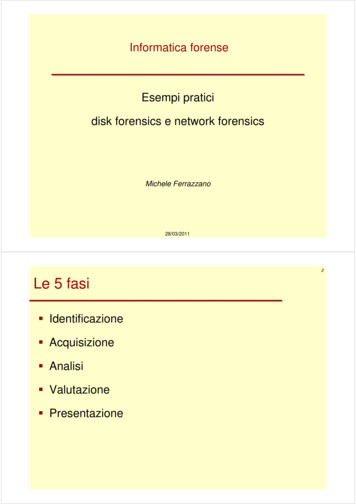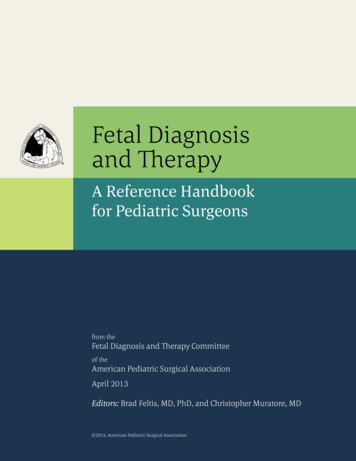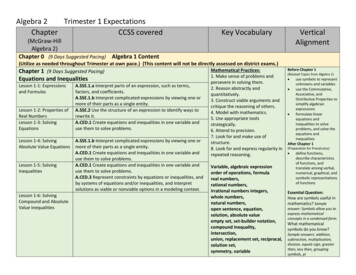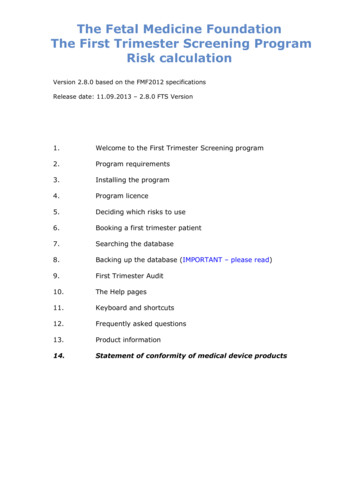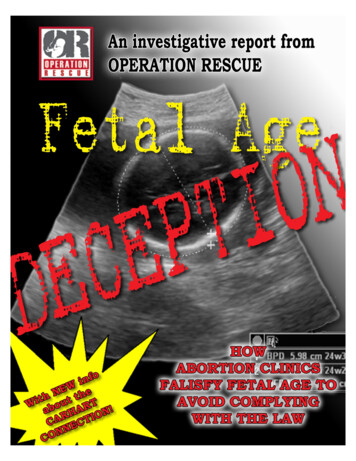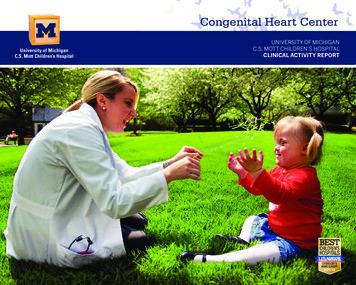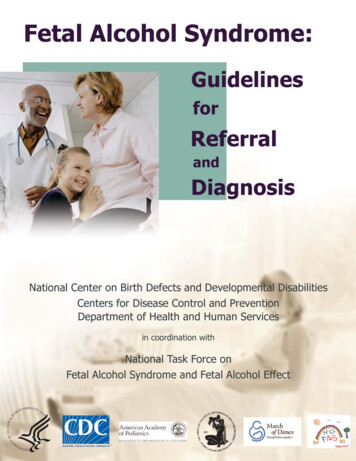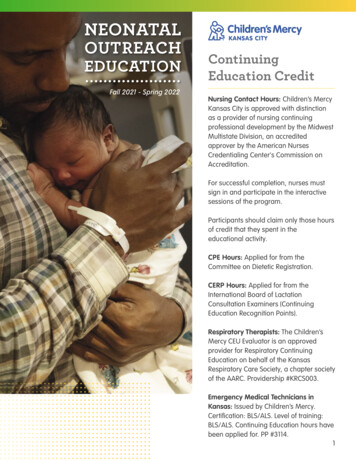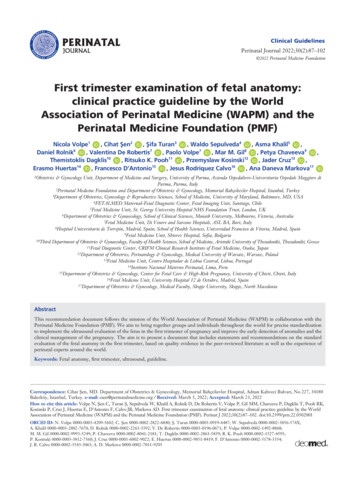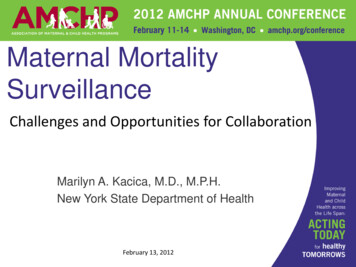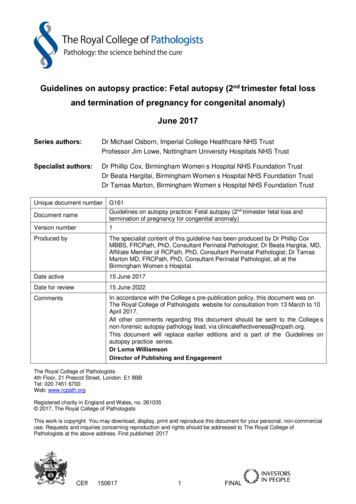
Transcription
Guidelines on autopsy practice: Fetal autopsy (2nd trimester fetal lossand termination of pregnancy for congenital anomaly)June 2017Series authors:Dr Michael Osborn, Imperial College Healthcare NHS TrustProfessor Jim Lowe, Nottingham University Hospitals NHS TrustSpecialist authors:Dr Phillip Cox, Birmingham Women’s Hospital NHS Foundation TrustDr Beata Hargitai, Birmingham Women’s Hospital NHS Foundation TrustDr Tamas Marton, Birmingham Women’s Hospital NHS Foundation TrustUnique document numberDocument nameVersion numberG161Guidelines on autopsy practice: Fetal autopsy (2nd trimester fetal loss andtermination of pregnancy for congenital anomaly)1Produced byThe specialist content of this guideline has been produced by Dr Phillip CoxMBBS, FRCPath, PhD, Consultant Perinatal Pathologist; Dr Beata Hargitai, MD,Affiliate Member of RCPath, PhD, Consultant Perinatal Pathologist; Dr TamasMarton MD, FRCPath, PhD, Consultant Perinatal Pathologist, all at theBirmingham Women’s Hospital.Date active15 June 2017Date for review15 June 2022CommentsIn accordance with the College’s pre-publication policy, this document was onThe Royal College of Pathologists’ website for consultation from 13 March to 10April 2017.All other comments regarding this document should be sent to the College’snon-forensic autopsy pathology lead, via clinicaleffectiveness@rcpath.org.This document will replace earlier editions and is part of the ‘Guidelines onautopsy practice’ series.Dr Lorna WilliamsonDirector of Publishing and EngagementThe Royal College of Pathologists4th Floor, 21 Prescot Street, London. E1 8BBTel: 020 7451 6700Web: www.rcpath.orgRegistered charity in England and Wales, no. 261035 2017, The Royal College of PathologistsThis work is copyright. You may download, display, print and reproduce this document for your personal, non-commercialuse. Requests and inquiries concerning reproduction and rights should be addressed to The Royal College ofPathologists at the above address. First published: 2017CEff1506171FINAL
ContentsForeword . 31Introduction . 42The role of the autopsy . 53Pathology of encountered at autopsy . 54Specific health and safety aspects . 55Consent . 66Clinical information relevant to the autopsy . 67The autopsy procedure . 68Limited autopsy. 89Specific organ systems to be considered . 810Organ retention . 811Histological examination . 812Toxicology . 913Other relevant samples (as indicated by history and macroscopic findings) . 914Imaging . 1015Autopsy report . 1016Criteria for audit . 1117References . 12Appendix AStructured autopsy request form . 14Appendix BSummary table – Explanation of grades of evidence . 16Appendix CAGREE compliance monitoring sheet . 17NICE has accredited the process used by The Royal College of Pathologists to produce itsclinical guidelines. Accreditation is valid until July 2022. More information on accreditation canbe viewed at www.nice.org.uk/accreditation.For full details on our accreditation visit: www.nice.org.uk/accreditation.CEff1506172FINAL v1
ForewordThe autopsy guidelines published by The Royal College of Pathologists (RCPath) are guidelinesthat enable pathologists to deal with non-forensic consent and Coroners’ post-mortemexaminations in a consistent manner and to a high standard. They are written for the profession;some technical detail may be distressing to a lay audience.The guidelines are systematically developed statements to assist the decisions of practitioners andare based on the best available evidence at the time the document was prepared. Given that muchautopsy work is single observer and cannot realistically be repeated, it has to be recognised thatthere is no reviewable standard that is mandated beyond that of the FRCPath Part 2 examination.Nevertheless, much of this can be reviewed against ante-mortem imaging and other data. It maybe necessary or even desirable to depart from the guidelines in the interests of specific patientsand special circumstances. The medico-legal risk of departing from the guidelines should beassessed by the autopsy pathologist; just as adherence to the guidelines may not constitutedefence against a claim of negligence, so a decision to deviate from them should not necessarilybe deemed negligent.There is a general requirement from the General Medical Council to have continuing professionaldevelopment (CPD) in all practice areas and this will naturally encompass autopsy practice. Thosewishing to develop expertise/specialise in pathology are encouraged to seek appropriateeducational opportunities and participate in the relevant EQA scheme.The guidelines themselves constitute the tools for implementation and dissemination of goodpractice.The stakeholders consulted for this document were:·British and Irish Paediatric Pathology Association (BRIPPA)·Stillbirth and Neonatal Death Charity (SANDS)·The Royal College of Obstetricians and Gynaecologists (RCOG)·Antenatal Results and Choices (ARC)·Miscarriage Association·Human Tissue Authority (HTA) and its Histopathology Working Group, which includesrepresentatives from the Association of Anatomical Pathology Technology, Institute ofBiomedical Science, The Coroners Society of England and Wales, the Home Office ForensicScience Regulation Unit and Forensic Pathology Unit and the British Medical Association.The information used to develop this document was derived from current medical literature and aprevious version of this guideline. As far as possible, this guideline is based on publishedevidence, but where this does not exist it represents custom and practice, and is based on thesubstantial clinical experience of the authors and colleagues. All evidence included in thisguideline has been graded using modified SIGN guidance – see Appendix B.No major organisational changes or cost implications have been identified that would hinder theimplementation of the guidelines.A formal revision cycle for all guidelines takes place on a five-year cycle. The College will ask theauthors of the guideline, to consider whether or not the guideline needs to be revised. A fullconsultation process will be undertaken if major revisions are required. If minor revisions orchanges are required a short note of the proposed changes will be placed on the College websitefor two weeks for members’ attention. If members do not object to the changes, the short notice ofchange will be incorporated into the guideline and the full revised version (incorporating thechanges) will replace the existing version on the College website.CEff1506173FINAL v1
The guideline has been reviewed by the College’s Clinical Effectiveness Department, DeathInvestigations Group, Lay Governance Group and Publications Department and was placed on theCollege website for consultation with the membership from 13 March to 10 April 2017. Allcomments received from the membership were addressed by the author to the satisfaction of theDirector of Publishing and Engagement.This guideline was developed without external funding to the writing group. The College requiresthe authors of guidelines to provide a list of potential conflicts of interest; these are monitored bythe Clinical Effectiveness Department and are available on request. The authors of this documenthave declared that there are no conflicts of interest.1IntroductionPost-mortem examination of a baby following spontaneous or missed miscarriage in thesecond trimester (11 0–23 6 weeks gestation) may provide a complete or partial explanationof the pregnancy loss, whilst following termination of pregnancy for fetal abnormality a postmortem examination may provide a specific diagnosis. In all situations post-mortem mayprovide information relevant to the management of subsequent pregnancies.1-4 Autopsy isthe single most useful investigation and provides information that changes or significantlyadds to the clinical diagnosis in nearly half of cases.5,6 The autopsy is also a valuable audit ofclinical care and may facilitate learning from adverse events.This guideline has been created to assist the pathologist undertaking autopsies in cases ofsecond trimester (late) miscarriage, second trimester intrauterine death (missed miscarriage)and termination of pregnancy for fetal abnormality. It provides practical technical advice onperforming the autopsy, guidance on the use of additional investigations and minimumstandards for the content of the autopsy report. It is intended as a guide to reasonablepractice, rather than a policy statement. If followed, the output from the autopsy should besufficient to provide useful feedback to the family, to the clinicians involved in the case andfor local and national audit. Where possible, references are provided, but it is inevitable thatmany of the suggestions are based on common UK practice rather than on publishedevidence, as the latter is often non-existent or sparse. Many pathologists have adoptedapproaches based on their own experience, evidence and resources, which may differ fromthese guidelines but achieve the same outcome. This document does not aim to changesuch approaches. In addition, the document is not intended as a replacement for standardtextbooks, but highlights the principles of undertaking and reporting perinatal autopsies. Fordetailed guidance on undertaking the autopsy in specific circumstances, the reader isreferred to the ‘Further reading’ list below.In England, Wales and Northern Ireland, autopsy facilities and procedures must be coveredby appropriate licences issued by the HTA and consent procedures must be compliant withthe relevant HTA Code of Practice.7 Separate legislation applies in Scotland, which does notimpose a system of licensing.As with other complicated autopsy scenarios such as maternal deaths, it is preferable that allfetal autopsies are performed by a perinatal/paediatric pathologist or a generalhistopathologist with an interest and suitable expertise in such matters.1.1Target users of this guidelineThe target primary users of this guideline are UK consultant and trainee perinatal/paediatricpathologists and general histopathologists with an interest in perinatal pathology. Therecommendations will also be of value to pathologists working outside the UK, obstetricians,neonatal paediatricians and bereavement midwives.CEff1506174FINAL v1
2The role of the autopsyThe role of the autopsy is to:·3provide information regarding the baby to the bereaved family–establish the immediate cause of second trimester miscarriage or factors that mayhave contributed to the pregnancy loss–identify the immediate cause of second trimester intrauterine death (missedmiscarriage)–identify concomitant diseases, particularly those with implications for subsequentpregnancies (e.g. growth restriction, malformation, maternal diabetes)–identify evidence of genetic disease and to allow determination of the likelyrecurrence risk·provide pathology input for local perinatal mortality, fetal medicine or clinical geneticsreview meetings·provide information for audit purposes (e.g. antenatal diagnosis, pregnancy andintrapartum care)·provide information for national clinical outcome review programmes and local ornational congenital malformation registers.Pathology encountered at autopsy·Amniotic infection sequence·Oligohydramnios·Growth restriction: symmetric, asymmetric (nutritional)·Viral/protozoal infection (CMV, Parvovirus, toxoplasmosis, other)·Congenital malformation (all systems)·Hydrops fetalis·Fetal akinesia sequence·Placental and umbilical cord disease·Changes in the baby and placenta secondary to intrauterine death.The above is not an exhaustive list and users are referred to the relevant textbooks.4Specific health and safety aspectsThe pathologist needs to know the results of the antenatal infection screens.In regions of high maternal HIV prevalence, autopsy practice using universal precautions willsignificantly protect against accidental transmission.CEff1506175FINAL v1
5Consent·Regardless of the gestation, post-mortem examination may only be performed ifinformed consent has been given, typically by the mother or both of the parents. Fetaltissue is considered in law to be the mother’s tissue, and therefore tissue from the living.·The consent process should be compliant with the requirements of the HTA’s Code ofPractice: Code A: Guiding Principles and the Fundamental Principle of Consent.7·The autopsy consent form should be compliant with the model ‘Consent form forperinatal post mortem’ developed by SANDS, the stillbirth and neonatal death charity, inconsultation with the HTA.8·The pathologist performing the autopsy must see the completed consent form, either asa physical copy or electronically, before commencing the autopsy. Any limitations on thescope of the autopsy must be complied with.·Any concerns regarding the validity of the consent should be resolved beforecommencing the autopsy.[Level of evidence: D]6Clinical information relevant to the autopsy(Best obtained using structured request form, see Appendix A.)·Patient identification details.·Maternal age/date of birth.·Maternal height, weight and BMI.·Relevant medical and family history, including consanguinity.·Obstetric history, previous pregnancies/deliveries, including previous fetal and neonatallosses (and if post-mortem examination had been carried out), malformation and growthrestriction and other complications.·History of current pregnancy, including:–estimated delivery date–antenatal infection screen, including HIV–abnormal findings from ultrasound or other antenatal investigations (copies ofreports are helpful)–hypertension/bleeding/pyrexia/membrane rupture–events leading up to delivery–for late miscarriages, live born or stillborn.[Level of evidence: GPP]7The autopsy procedure9·CEffRequires availability of appropriately sized instruments for small and very small fetuses;balances for weighing babies and organs (to at least nearest 0.1 g); charts of normalvalues (baby weight and measurements, organ weights and placenta weight)1506176FINAL v1
·Whole body X-ray for gestational assessment, malformation, etc. Recommended in allcases; mandatory for suspected skeletal dysplasia. Other imaging modalities may beappropriate in some circumstances and if available.·Photography recommended in all cases, essential to document external and internalabnormalities. Digital photography and secure storage preferred.·Routine external body measurements (body weight, crown-rump length, crown-heellength, foot length, occipito-frontal circumference)·Detailed external examination, including: muscle bulk, maceration, local/generalisedoedema, pallor, dysmorphic features, assessment of patency of orifices (includingchoanae) and palatal fusion, limbs, hands and feet and genitalia·T- or Y-shaped skin incision on body·Central nervous system (CNS) examination:··–median posterior or transverse posterior parietal scalp incision–observation of maturity to assist gestational assessment–consider removal under water–if suspected CNS malformation (including ventriculomegaly), examination ofposterior fossa structures by posterior approach.–Consider referring the whole central nervous system for neuropathologicalexamination in appropriate cases. This may include sampling peripheral nervoustissue (nerve root, peripheral nerve, muscle etc). Consulting the neuropathologyteam may be helpful if there is doubt about sampling.Detailed systematic examination of other internal organs, including:–umbilical arteries and vein, ductus venosus–in situ examination of the heart and great vessels with sequential segmentalanalysis of malformations–in situ examination of thoracic and abdominal organs; consider removing incontinuity to assess abnormal structures crossing diaphragm–weights of internal organs (minimum: brain, heart, lungs, liver, kidneys, thymus,adrenals, spleen)–apply special dissection techniques where appropriate.Detailed examination of placenta and umbilical cord, including:–trimmed weight (after extraplacental membranes and cord detached)–dimensions of placenta (width in two planes and thickness)–umbilical cord: length, diameter, insertion into placental disc, number of vessels,coiling, lesions–membranes: appearance–fetal surface/chorionic vessels: appearance, infection–maternal surface: completeness, craters–slicing at approximately 1 cm intervals to evaluate parenchyma for colour and focalabnormalities.[Level of evidence: GPP]CEff1506177FINAL v1
8Limited autopsyWhere consent for a full autopsy is not given, limited examination may be of value.10Forms of limited examination include:·autopsy limited to one or more body cavities·open or needle biopsy of specific internal organs (if feasible)·external examination of the body with X-ray, photography and genetics (if indicated)·placental examination only (with genetic testing if indicated)11·imaging (CT, MRI – if available) alone or with targeted biopsies.12[Level of evidence: C]9Specific significant organ systemsNone. All are of significance.10Organ retention·Short-term retention of organs to allow fixation does not require specific consent,provided they are reunited with the body before release for burial/cremation.·Specific consent should be sought for long-term retention beyond the release of thebody, for the purpose of examining the organs. Consider for extra-cranial organs withcongenital malformations (particularly heart) if input not available from a perinatalpathologist or cardiac morphologist on site at the time of examination, and theabnormality cannot be satisfactorily recorded by photography.·Brain for macroscopic and histological assessment. In practice, submersion for aminimum of 2–3 days in 20% formalin ( 5% acetic acid) will usually produce sufficientfixation to allow adequate sectioning and block sampling to allow the brain to be returnedto the body before release for funeral. If there is doubt consult the local neuropathologyteam.[Level of evidence: GPP]11Histological examinationRecommended blocks required at full autopsy:9CEff·thymus·heart (septum and free walls)·lungs (right and left – each lobe)·liver (both major lobes)·pancreas·spleen·adrenal glands1506178FINAL v1
·kidneys·muscle and diaphragm·stomach, small and large bowels·larynx/trachea and thyroid·bone: rib including growth plate in stillbirth; long bone (including growth plate), vertebralbody and skull mandatory for suspected skeletal dysplasia·brain: if preservation allows include cerebral cortex and periventricular white matter(frontal, parietal, temporal and occipital), deep grey matter (caudate, striatum, thalamus),hippocampus, midbrain (inferior colliculi), pons, medulla (inferior olives), cerebellum withdentate nucleus. Sampling may by necessity be more restricted if there is advancedautolysis·other organ lesions as appropriate·placenta (at least three full-thickness blocks, plus focal lesions)·membrane roll·umbilical cord (at least two).[Level of evidence: D]A record of the samples taken should be kept and tissue blocks and slides should betraceable within the laboratory, in line with the requirements of HTA and the UK AccreditationService.12ToxicologyNone required.13Other samples (as indicated by history and macroscopic findings)···Bacteriology (may be helpful when there is amniotic infection):–lung (swab/tissue)–blood (swab/formal culture)–other, as dictated by clinical history or macroscopic findings.Genetics:–skin/muscle/cardiac blood–placenta–other samples as recommended by local genetics department–consider retention of frozen tissue sample (liver/lung/other) as further DNA resource.Virology–·Biochemistry, electron microscopy–CEffSamples as indicated by clinical history or macroscopic findings.Consider in cases of fetal akinesia and hydrops fetalis, if tissue preservation allows.1506179FINAL v1
·Fibroblast culture and/or snap frozen liver/muscle for metabolic biochemistry if indicated.[Level of evidence: D]1-414ImagingImaging-based post-mortem examination should never be undertaken without an expertexternal examination of the body having first been performed by an appropriately trained andexperienced individual. Imaging modalities, in addition to X-ray, which may be of valueinclude MRI12 and micro-CT13.The role of MRI imaging in perinatal autopsies has been investigated.12 MRI imaging cangive useful information, particularly on structural malformations; however, it is poor indetecting infection and in cases of significant maceration. Targeted biopsies may also beconsidered, but both MRI imaging and the equipment and skills needed to take endoscopicbiopsies at post-mortem examination are currently not widely available.[Level of evidence: C]15Autopsy reportIf resources allow, units may choose to issue a provisional report giving details of themacroscopic findings, shortly after the examination of the body, followed by a final reportwhen all histology and other tests have been completed. Alternatively, only a single finalreport may be produced.The report should include the following sections:9·demographic and identification data·details of autopsy consent and limitations·body weight and appropriateness for gestation·body measurements·list of main findings·clinicopathological summary (final report)·summary of clinical history·systematic description of external and internal findings and placental examination·organ weights with relevant reference values and ratios·details of ancillary tests taken (and results – final report)·histology (final report)·list of histology tissue blocks (final report).[Level of evidence: GPP]15.1 Clinicopathological summaryThe summary should include:·CEffan assessment of gestational age at death15061710FINAL v1
16·in second trimester intrauterine death, the degree of maceration and likely timing andcause of death (if determined)·in miscarriage, the likely cause of the miscarriage·as appropriate, explicit statements regarding the presence/absence of growth restriction,malformation and infection (negative findings are helpful and may be crucial)·for termination of pregnancy, concordance or discordance of findings with the clinicalhistory and prenatal testing, likely/possible unifying diagnosis and recommendation forgenetic referral or further tests if appropriate·identification of those cases with an increased risk of recurrence (including geneticdisease, growth restriction, placental pathology) and requirement/possibility of additionaltesting.Criteria for auditThe following standards are suggested criteria that might be used in periodic reviews toensure a post-mortem examination report meets national standards··CEffSupporting documentation:–standards: supporting documentation was submitted with the body in 95% of cases.(NB it is recommended that an autopsy should not be commenced in the absence ofclinical information)–standards: 95% of submitted information is satisfactory, good or excellent–standards: a correctly completed autopsy consent form, meeting nationalrequirements is submitted with 95% of cases. (NB an autopsy must not becommenced unless the pathologist has seen a physical copy of the consent formand it is correctly completed).Autopsy report:–standards: 100% of autopsy reports must include all of the sections detailed insection 15 (above)–standards: in 100% of autopsy reports the information documented is satisfactory,good or excellent–standards: in 100% of autopsy reports the clinicopathological summary is clear andconcise and when appropriate, contains the information detailed above.15061711FINAL v1
17References1.Meier PR, Manchester DK, Shikes RH, Clewell WH, Stewart M. Perinatal autopsy: its clinicalvalue. Obstet Gynecol 1986;67:349–351.2.Porter HJ, Keeling JW. Value of perinatal necropsy examination. J Clin Pathol 1987;40:180–184.3.Faye-Petersen OM, Guinn DA, Wenstrom KD. Value of perinatal autopsy. ObstetGynecol 1999;94:915–920.4.Gordijn SJ, Erwich JJ, Khong TY. Value of the Perinatal Autopsy: Critique. Pediatric andDevelopmental Pathology 2002;5:480–488.5.Johns N, Al-Salti W, Cox P, Kilby MD. A comparative study of prenatal ultrasound findingsand post-mortem examination in a tertiary referral centre. Prenat Diagn 2004;24:339–346.6.Saller DN Jr, Lesser KB, Harrel U, Rogers BB, Oyer CE. The clinical utility of the perinatalautopsy. JAMA 1995;273:663–665.7.Human Tissue Authority. Codes of Practise. Accessed December 2016. Available ctice8.The Stillbirth and Neonatal Death Charity. The Sands perinatal post mortem consentpackage m-consent-package(accessed December 2016)9.The Royal College of Obstetricians and Gynaecologists and Royal College of Pathologists.Fetal and Perinatal Pathology: Report of a Joint Working Party. London: RCOG Press, 2001.10.Wright C, Lee RE. Investigating perinatal death: a review of the options when autopsyconsent is refused. Arch Dis Child Fetal Neonatal Ed 2004;89:285–288.11.Heazell AE, Martindale EA. Can post-mortem examination of the placenta help determine thecause of stillbirth? J Obstet Gynaecol 2009;29:225–228.12.Thayyil S, Sebire NJ, Chitty LS, Wade A, Chong W, Olsen O et al. Post-mortem MRI versusconventional autopsy in fetuses and children: a prospective validation study. Lancet2013;382:223–233.13.Lombardi CM, Zambelli V, Botta G, Moltrasio F, Cattoretti G, Lucchini V et al. Postmortemmicrocomputed tomography (micro-CT) of small fetuses and hearts. Ultrasound ObstetGynecol 2014;44:600–609.Further reading1.Wigglesworth JS, Singer DB (eds). Textbook of Fetal and Perinatal Pathology, Volume 2(2nd edition). Malden: Blackwell Science, 1998.2.Khong TY. The perinatal necropsy. In: Khong TY, Malcomson RDG (eds). Keeling’s Fetaland Neonatal Pathology (5thedition). London: Springer, 2015.3.Bove KE. Practice guidelines for autopsy pathology – the perinatal and pediatric autopsy.Arch Pathol Lab Med 1997;121:368–376.CEff15061712FINAL v1
4.Gilbert-Barness E, Kapur R, Oligny LL, Siebert J (eds.). Potter’s Pathology of the Fetus,Infant and Child (2ndedition). Philadelphia: Mosby Elsevier, 2007.5.Baergen RN. Manual of Pathology of the Human Placenta (2nd edition). New York: Springer,2011.CEff15061713FINAL v1
Appendix ASpecimen autopsy request formClinical information for fetal/perinatal post-mortem examinationPlease attach mother’s sticker herePlease attach baby’s sticker hereFamily name .Family name .First name .First name .DOBDOB////Reg no .Reg no .Consultant .Consultant .Ethnic originFather’s ethnic origin (if known)Referring hospitalBaby’s sex: M/FWardHospital of birth (if different)RELEVANT HISTORY:Maternal height:cmPrevious pregnancies: GBooking xOutcome1.2.3.4.5.THIS PREGNANCY: booked / unbookedGestation: by dates:HBsAg pos / neg/40by scan :LMPEDD/40 weeksBMIBlood group :, Rh D pos / negRed cell antibodiesTrisomy screening resultsMedicationsAbnormal USS findingsAntenatal diagnostic procedures / results:Karyotype:Threatened abortion: no / yes WhenSevere anaemia: no / yesAntepartum haemorrhage: no / yes WhenInfection risk: low / high ReasonHypertension: no/yes max b.p.Maternal pyrexia: no / yes WhenPre-eclampsia: no/ yes whenOther problemCEff15061714FINAL v1
LABOUR: onset: spont. / medical/ none IOL for: IUD / TOP / otherPresentation: vertex / breech / otherLiquor volume: normal / reduced / increased; colourRupture of membranes: date1st stage:hmin 2nd stage:Fetocide: y / n datetimehAugmentation (Syntocinon): yes / nominFetal heart last heard (S/B): datetimeFetal distress: yes / no specifyDelivery: spontaneous
adds to the clinical diagnosis in nearly half of cases.5,6 The autopsy is also a valuable audit of clinical care and may facilitate learning from adverse events. This guideline has been created to assist the pathologist undertaking autopsies in cases of second trimester (late) miscarriage, second trimester intrauterine death (missed miscarriage)
